

Unit I. Hybrid-Flexible Course Design to Support Student-Directed Learning Paths - Hybrid-Flexible Course Design. Webbs DOK Flip Chart. M1 Slide 19 DOK Wheel Slide. 4 Questions That Will Lead You to the Perfect eLearning Course. As an instructional designer, your primary goal is to develop effective eLearning courses.
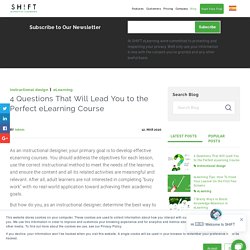
You should address the objectives for each lesson, use the correct instructional method to meet the needs of the learners, and ensure the content and all its related activities are meaningful and relevant. After all, adult learners are not interested in completing "busy work" with no real-world application toward achieving their academic goals. But how do you, as an instructional designer, determine the best way to create effective eLearning courses? As with any project, gathering necessary information upfront is beneficial to obtain a successful output.
Try asking yourself these four questions, they will provide clarity and will avoid possible traps in the process: Successful instructional planning requires understanding the learning characteristics and needs of the students. Instructional Design: A Paradigm Shift. The basis for instructional design and technology lies in theory; well-designed and effective instruction is the tangible embodiment of theory.
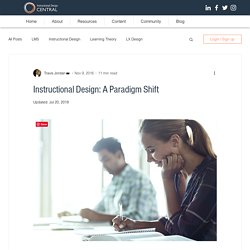
Over the years, theoretical frameworks have been used as the grounding device to which all research, design principles, and the subsequent implications for instruction gravitate. 4 Step Microlearning 2019 1. Puxr17f4CivkfetlfWiX Digital Learning Innovation Trends PDF. Inclusive Teaching and Course Design. Faculty and instructional designers can employ a number of strategies to create courses and learning environments where students feel welcome and connected.
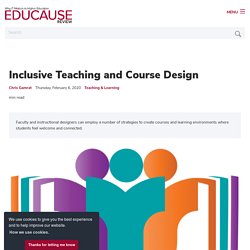
As an instructional designer, I've thought a lot about the value of diversity, equity, and inclusion (DEI) in the context of teaching and learning. But where to start? Determining how best to incorporate DEI into course design and teaching was overwhelming. I began by reading articles and attending workshops, but I still felt that while I was gaining perspective on students' needs, I didn't know how to focus my energy to effect change. That is when I decided to create a list of considerations to help faculty and instructional designers create courses and learning environments where students feel welcome and connected. Setting Expectations on the First Day Faculty can use a number of techniques to connect with students on the first day of class and show students that they care.
Connect as a person. Reflect on scenarios. Analytics in Course Design: Leveraging Canvas Data. Desirability, Feasibility, Viability: The Sweet Spot for Innovation. The ideal innovation process is the trifecta of desirability, feasibility and viability, an idea that originated from IDEO in the early ’00s ( If your idea meets all three criteria, then it contains these essential characteristics: A desirable solution, one that your customer really needsA feasible solution, building on the strengths of your current operational capabilitiesA profitable solution, with a sustainable business model.
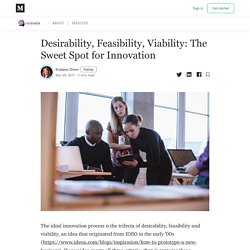
But if you miss any one of these, implementing the idea becomes riskier and costlier. I often work with teams who are pursuing a grand vision, an idea that could really have an impact for their customers and for their business. This vision is fantastic, even necessary for keeping the team motivated and going in the right direction. Introduction to Learning Objectives and Backward Design. Design Thinking. Design thinking simultaneously considers what is desirable from a human point of view, what is technologically feasible, and what is economically viable.
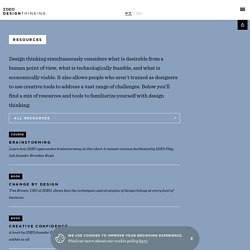
It also allows people who aren’t trained as designers to use creative tools to address a vast range of challenges. Below you’ll find a mix of resources and tools to familiarize yourself with design thinking: Course Brainstorming Learn how IDEO approaches brainstorming in this short 2-minute session facilitated by IDEO Play Lab founder Brendan Boyle.
IDEO Design Thinking. Design Thinking: A Quick Overview. If you have just started embarking your journey through the Design Thinking process, things might seem a little overwhelming. This is why we have prepared a useful overview of the Design Thinking process, as well as some of the popular Design Thinking frameworks commonly used by global design firms and national design agencies. To begin, let’s have a quick overview of the fundamental principles behind Design Thinking: Design Thinking starts with empathy, a deep human focus, in order to gain insights which may reveal new and unexplored ways of seeing, and courses of action to follow in bringing about preferred situations for business and society. It involves reframing the perceived problem or challenge at hand, and gaining perspectives, which allow a more holistic look at the path towards these preferred situations.
It encourages collaborative, multi-disciplinary teamwork to leverage the skills, personalities and thinking styles of many in order to solve multifaceted problems. Deep-Dive. Inclusive Teaching and Course Design. 53 Best Resources for New Instructional Designers images in 2019. UbD WhitePaper0312. Chapter 9. Brief Understanding the Curriculum Design Process. Role of an Instructional Designer in Curriculum Development. Why is it important to use Instructional Designers (IDs)?
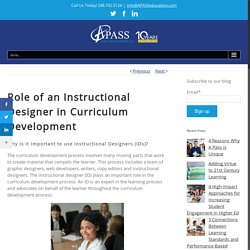
The curriculum development process involves many moving parts that work to create material that compels the learner. This process includes a team of graphic designers, web developers, writers, copy editors and instructional designers. The instructional designer (ID) plays an important role in the curriculum development process. An ID is an expert in the learning process and advocates on behalf of the learner throughout the curriculum development process. The ID’s role To get a better understanding of what an ID does, let’s look at tasks they complete in the curriculum development process. Conducts a needs assessment to determine what the learner needs to know and what gap of knowledge exists.Identifies the learning environment and existing equipment available for the learners.Asks questions such as: Do the learners have access to Microsoft Word? The benefits of working with an ID. H5P – Create and Share Rich HTML5 Content and Applications.
Apps for Education. Adobe Apps for Education Adobe Apps for Education provides an introduction to Adobe software applications, helps you learn what you can create, and inspires with ideas for sample projects using these tools.
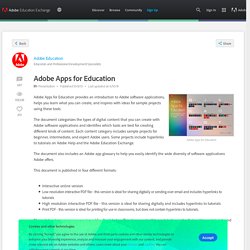
The document categorizes the types of digital content that you can create with Adobe software applications and identifies which tools are best for creating different kinds of content. Each content category includes sample projects for beginner, intermediate, and expert Adobe users. Some projects include hyperlinks to tutorials on Adobe Help and the Adobe Education Exchange. The document also includes an Adobe app glossary to help you easily identify the wide diversity of software applications Adobe offers. Demystifying Instructional Design Software - Synapse. Learning and development teams have many options when it comes to instructional design software.
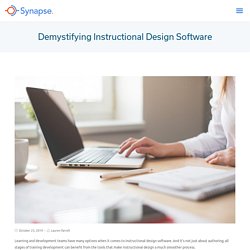
And it’s not just about authoring; all stages of training development can benefit from the tools that make instructional design a much smoother process. But figuring it all out can be a daunting task! Finding Our Voice: Instructional Designers in Higher Education. Key Takeaways A New Jersey workshop on instructional design gave attendees the opportunity to learn about instructional designers' roles at different institutions and brainstorm good ideas, tips and tricks, important contributions to the field, and how to overcome shared challenges.Instructional technologists and video production coordinators also are involved in the instructional design process, helping faculty learn how to use instructional tools.A major challenge for instructional designers is faculty resistance to new pedagogies and deliveries — not just to hybrid and online courses.Institutional acknowledgement of skill acquisition in their professional development can lead faculty to place a higher value on technology integration in teaching and learning.
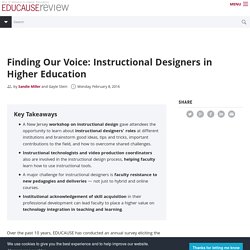
Over the past 10 years, EDUCAUSE has conducted an annual survey eliciting the top 10 IT issues in higher education. Here we describe some of the outcomes from this intensive, executive-style workshop. Starting the Conversation. Finding Our Voice: Instructional Designers in Higher Education. How To Get A Job As An Instructional Designer. The One Skill You Need to Excel in Instructional Design. Sticking to the Instructional Design Basics - What, Why, How. 3 Chunking Strategies That Every Instructional Designer Should Know. 17 AF07WSII Instructional Design Criteria Checklist. Course Review Checklist. A Compact Instructional Design Review Checklist. 3 Reasons Why Failing As Instructional Designers is OK and Encouraged. Top 10 Instructional Designer Skills.